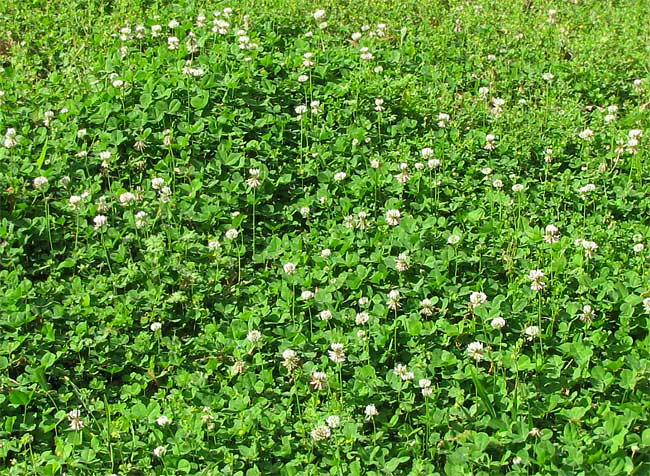
An Excerpt from Jim Conrad's
NATURALIST NEWSLETTER
March
30, 2009
issued
from the woods near Natchez, Mississippi, USA

When I took the clover pictures for the above section the sun was shining, the odor of crushed herbage on a warm, moist spring day blossomed around me, soft grass and clover tickled my feet, and the white, breeze-jiggled clover heads in their green ocean were simply beautiful. I just had to lie a spell in the clover experiencing it all.
Yet, also last weekend was the very weekend in the Natchez area when most people mowed their lawns for the first time this year. Saturday the whole landscape vibrated with lawnmower sounds and... one lawn after another graced with beautiful sprays of bee- and butterfly-visited White Clover was reduced to manicured, monoculture, sterile grass lawns.
Of course I understand the cultural imperative behind mowed lawns. If you don't keep your lawn mowed, neighbors think you're lazy. Also, many people -- most in this middle-American culture -- actually believe that mowed, monoculture lawns are pretty.
Referring to the kinds of oversized lawns so typical around here, let it be known that at least in the eyes of this one person, me, large, mowed lawns around houses are ugly and profane. Again, I'm referring to large lawns, not lawn spaces immediately around a house needed for air circulation, as a fire barrier, keeping down mosquitoes, or as a romping space for kids and pets.
Excessively large lawns are cultural relicts of an outdated headset in which Nature is regarded as the enemy to be dominated and controlled. By occupying space that could be left wooded or allowed to revert to woods, or converted to garden, large lawns document people's gross insensitivity and irreverence toward Life on Earth. Large lawns maintained with fertilizers and pesticides are malignant, running sores in an ecosystem trying to support us. Because large lawns gather heat where a forest or garden could cool, and mowers spew noxious clouds of carbon dioxide and particulate matter where growing trees and gardens could convert carbon dioxide to life-giving oxygen and clean the air, in these days when educated people recognize the dangers of global warming and the need for clean air, large lawns are shameful symbols of intellectual laziness, apathy and wrongheadedness.
The same is to be said of those who design and build highways with large, grassy medians separating lanes, and developers who automatically scalp areas before building homes.
Someday people will rejoice when clover, dandelions, oxalis, chickweed, henbit, blue violets and all the rest migrate into small grassy spaces around their homes. Someday these plants when they come into our yards will be universally welcomed not only for their blossoms' cheerful colors and sweet scents, but also for how they rehabilitate and enrich the soil.
Someday a critical mass of people will finally get the points that -- especially in our own living spaces -- diversity is sacred; that the Web of Life is beautiful, and; that no Community of Living Things should ever be mindlessly, unfeelingly destroyed just because "everyone else is doing it" or because of an unconscionably outdated esthetic sense.
Long live clover in shaggy spring lawns! .